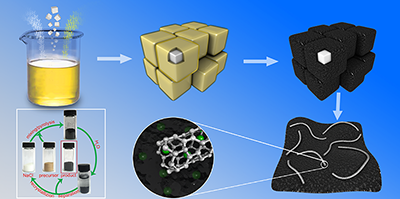Sodium Chloride-Assisted Green Synthesis of 3D Fe-N-C Hybrid as a Highly Active Electrocatalyst for Oxygen Reduction Reaction
Yun Zhang, Lin-Bo Huang, Wenjie Jiang, xing Zhang, YuYun Chen, Zidong Wei, Li-jun Wan and Jin-Song Hu
J. Mater. Chem. A, 2016, 4, 7781-7787
Received 25 Feb 2016, Accepted 04 Apr 2016
Abstract (click for pdf file)

To promote the oxygen reduction reaction (ORR) on a non-noble-metal catalyst, integrating two-dimensional (2D) nanosheets and one-dimensional (1D) nanotubes in one catalyst is considered as one of desirable approaches since this hybrid architecture can host more useful active sites and enhance mass/electron transfer. Herein, we demonstrated a sodium chloride-assisted strategy for the in-situ synthesis of a three-dimensional (3D) hybrid of carbon nanosheets and nanotubes. The micrometer-scale sodium chloride (NaCl) crystal acted as a recyclable skeleton to adsorb the precursors on its surfaces, which assisted the formation of micrometer-sized graphitic carbon nanosheets in a thickness of nanometers by template effect during the pyrolysis, and the formation of iron-based nanocrystals in tens of nanometers by helping the distribution of iron sources and preventing their aggregation. The small iron-based nanocrystals favored the growth of long CNT connected to carbon nanosheets, and the outmigration of carbon atoms during the cooling process which led to the formation of carbon-layer encapsulated metallic iron nanoparticles between the carbon nanosheets or inside the carbon nanotubes. Benefiting from these features, the developed hybrid exhibited a significantly enhanced electrocatalytic activity and durability for ORR. The results may open up opportunities in exploring cost-effective high-performance electrocatalysts for energy applications.
